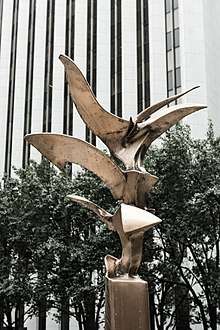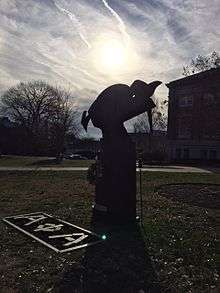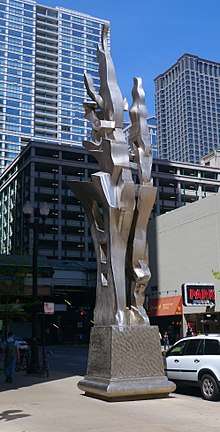Richard Hunt (sculptor)
| Richard Hunt | |
|---|---|
| Born |
September 12, 1935 South Side, Chicago, Illinois, United States |
| Nationality | United States |
| Education | School of the Art Institute of Chicago |
| Alma mater | School of the Art Institute of Chicago |
| Occupation | sculptor |
| Home town | Chicago |
| Website | http://www.richardhunt.us |
Richard Hunt (born September 12, 1935) is an American sculptor with over 125 sculptures for public display in the United States. Hunt has served on the Smithsonian Institution's National Board of Directors. Hunt’s abstract, contemporary sculpture work is notable for its presence in public displays as early as the 1960s, despite social pressures for the obstruction of African-American art at the time.
Early life and education
He was born in 1935 on Chicago's South Side. Hunt and his younger sister Marian grew up in South Side Chicago, but moved to Galesburg, Illinois at eleven years old where he spent majority of his time in the city of Chicago.[1] From an early age he was interested in the arts, as his mother, an artist and librarian, would bring him to performances by local opera companies that sang classical repertoires of Mozart, Rossini, Verdi, and Handel.[2] As a young boy, Hunt began to show enthusiasm and talent in artistic disciplines such as drawing and painting, and also sculpture, an interest that grew more and more as he got older. Hunt was inspired to pursue his career in the arts because his family appreciated art and he clearly said "My mom was supportive and dad was tolerant".[3] In the seventh grade, Hunt attended the Junior School of Art Institute of Chicago where he began his interest in art.[4] Hunt also acquired business sense and awareness of social issues from working for his father in a barbershop.[5]
As a teenager, Hunt began his work in sculpture, working in clay and carvings.[6] While his work started in a makeshift studio in his 1950 bedroom, he eventually built a basement studio in his father's barbershop.[6] Hunt not only embraced the medium of metal and the techniques of sculpting, but studied non-art subjects at University of Chicago and University of Illinois before entering the Art Institute of Chicago. The non-art subjects that Hunt first work with were objects he found. He was once interested in Surrealism where he experiment with the assemblage of broken machine parts and metals from the junkyard such as car bumpers and reshaping them into organic forms.[7] Hunt worked with materials of copper, iron and then to steel and aluminum which led to him to produce a series of "hybrid figures" which where reference to human, animal and plant forms.[8] This where Hunt attains a combination of organic and industrial subject matter in his artwork. Hunt studied at the Art Institute of Chicago from 1953 to 1957, focusing on welding sculptures, but also studying lithography.[9] His earliest works were more figural than his later ones, and usually represented classical themes.[2] Hunt began exhibiting his sculptures nationwide while still a student at the School of the Art Institute of Chicago.[10] As a Junior, his piece “Arachne,” was purchased by the Museum of Modern Art in New York.[10] He received a B.A.E. from the Art Institute of Chicago in 1957.[10] Upon graduating, Hunt was awarded the James Nelson Raymond Foreign Travel Fellowship[11][12] and continued his studies in England, France, Italy, and Spain.[10] His time abroad solidified his belief that metal was the definitive medium of the twentieth century.[9] Upon returning from his studies abroad, Hunt served in the United States Army from 1958 to 1960.[11] He became the youngest exhibiting artist at the 1962 Seattle World's Fair.[10]

Career

Hunt began to experiment with materials and sculpting techniques, influenced heavily by progressive twentieth-century artists. Hunt was inspired to focus on sculpture because of the 1950s exhibition called the Sculpture of the Twentieth Century that was held at the Art Institute of Chicago in 1953.[14] The Sculpture of the Twentieth Century include works of Pablo Picasso, Juilo Gonzalez, and David Smith.[3] At the exhibition, this was the first time Hunt saw various artworks of welded metal. In fact, Hunt was also inspired and paid respect to European sculptor Duchamp -Villon whose 1914 bronze "Horse" was instructional.[15] Seeing these artists' works led Hunt to created abstract shapes by welding metal.
In the 1960s and 1970s, Hunt used car junkyards as his quarries and turned bumpers and fenders into abstract, welded sculptures.[2] Hunt also focused on linear-spatial arrangement of his materials where he followed Julio Gonzalez's footsteps into three dimensional structures.[16] This experimentation garnered critically positive response from the art community, such that Hunt was exhibited at the Artists of Chicago and Vicinity Show and the American Show, where the Museum of Modern Art purchased a piece for its collection. He was the youngest artist to exhibit at the 1962 Seattle World's Fair, a major international survey exhibition of modern art.
In fact, Hunt received his first sculpture commission in 1967 known as Play, which was commissioned by the State of Illinois Public Art Program.[17] The making of this sculpture led him to many other public commissions and was considered to be his second career as a public sculptor. Hunt has completed more public sculptures than any other artist in the country. As of January 20, 2015, Hunt has created over 125 sculptures for public display in the United States.[18] His signature pieces include Jacob's Ladder at the Carter G. Woodson Library in Chicago and Flintlock Fantasy in Detroit.
He was appointed by President Lyndon Johnson as one of the first artists to serve on the governing board of the National Endowment for the Arts and he also served on boards of the Smithsonian Institution. From 1980 to 1988, Hunt served as Commissioner of the Smithsonian Institution's National Museum of American Art.[11] From 1994 to 1997, Hunt served on the Smithsonian Institution's National Board of Directors.[11] Hunt is the recipient of numerous awards and honorary degrees.
In 1974, Hunt acquired a deactivated electrical substation near northern Chicago and repurposed it into a metal welding sculpture studio. The station came equipped with a crane, which was convenient for moving large sculpture pieces, and a spacious 40-foot ceiling. While handling the metal, Hunt works with two assistants.[19] Hunt describes metalworks as "free play of forms evolving, developing and contrasting with one another." [20]
Hunt has continued to experiment throughout his successful career, employing a wide range of sculptural techniques. Through his work, Hunt often makes comments on contemporary social and political issues.

Honors and awards
- Art Institute's Logan Prize, 1956
- Elected into the National Academy of Design, 1999
- Lifetime Achievement Award, International Sculpture Center, 2009[21]
Selected works
- A Bridge Across and Beyond (1978), Washington, D.C.
- Symbiosis (c. 1981), Washington, D.C.
- Build-Grow (1986), Jamaica, Queens, New York
- Build-Grow (1992), Washington, D.C.
Public collections[22]
- Albright-Knox Gallery, Buffalo, New York
- Art Institute of Chicago, Illinois
- Bentley Historical Museum, University of Michigan, Ann Arbor
- Birmingham Museum of Art, Alabama
- Brauer Museum of Art, Valparaiso, Indiana
- Butler Institute of American Art, Youngstown, Ohio
- Cincinnati Art Museum, Ohio
- Cleveland Museum of Art, Ohio
- Denver Art Museum, Colorado
- Detroit Institute of Arts, Michigan
- DuSable Museum, Chicago
- Frederik Meijer Gardens and Sculpture Park, Grand Rapids, Michigan
- Greenville County Museum of Art, Greenville, South Carolina
- Hirshhorn Museum and Sculpture Garden, Washington, D.C.
- Hunter Museum of Art, Chattanooga, Tennessee
- Indianapolis Museum of Art, Indiana
- Israel Museum, Jerusalem
- Kalamazoo Institute of Arts, Michigan
- Lakeview Museum of Arts and Sciences, Peoria, Illinois
- Laumeier Sculpture Park, St Louis, Missouri
- Los Angeles County Museum, California
- Metropolitan Museum of Art, New York City
- Milwaukee Art Museum, Wisconsin
- Minneapolis Institute of Art, Minnesota
- Museum of Contemporary Art, Chicago
- Museum of Modern Art, New York City
- Museum Moderner Kunst Stiftung Ludwig. Vienna , Austria
- Nassau County Museum of Art, Roslyn, New York
- National Academy Museum and School, New York City
- National Gallery of Art, Washington, D.C.
- Nelson-Atkins Museum of Art, Kansas City, Missouri
- New Jersey State Museum, Trenton, New Jersey
- Sheldon Swope Art Museum, Terre Haute, Indiana
- Smart Museum of Art, University of Chicago, Chicago
- Smithsonian American Art Museum, Washington, D.C.
- Snite Museum of Art, University of Notre Dame, Notre Dame, Indiana
- Speed Art Museum, Louisville, Kentucky
- Springfield Art Museum, Springfield, Missouri
- Storm King Art Center, Mountainville, New York
- Swope Art Museum, Terre Haute, Indiana
- Telfair Museums, Savannah, Georgia
- Virginia Museum of Fine Arts, Richmond, Virginia
- Weatherspoon Art Museum, University of North Carolina, Greensboro
- Whitney Museum of American Art, New York, City
- Wichita Art Museum, Wichita, Kansas
- York College, New York City
Footnotes
- ↑ "Richard Hunt". The American Mosaic: The African American Experience. 2017 – via The American Mosaic: The African American Experience.
- 1 2 3 Perry, Regenia A. (1992). Free within Ourselves: African American Artists in the Collection of the National Museum of American Art. Smithsonian Inst. pp. 91–93.
- 1 2 "Copper in the Arts Magazine: Thinking in Metal: Sculptor Richard Hunt". Copper.org. Retrieved 2017-11-18.
- ↑ "About". Richard Hunt. Retrieved 2017-12-19.
- ↑ "Richard Hunt". Thehistorymakers.com. Retrieved 12 December 2017.
- 1 2 "Richard Howard Hunt - Artist, Fine Art Prices, Auction Records for Richard Howard Hunt". Askart.com. Retrieved 12 December 2017.
- ↑ Patton, Sharon (1998). African-American Art. Oxford University Press.
- ↑ Marter, Joan (2011). The Grove encyclopedia of American art. 1. Oxford: New York: Oxford University Press.
- 1 2 "Richard Howard Hunt - Artist Biography for Richard Howard Hunt". Askart.com. Retrieved 12 December 2017.
- 1 2 3 4 5 "About Richard Hunt". Richardhuntstudio.com. Retrieved 12 December 2017.
- 1 2 3 4 "Resume". Richardhuntstudio.com. Retrieved 12 December 2017.
- ↑ "Untitled - The Art Institute of Chicago". Artic.edu. Retrieved 12 December 2017.
- ↑ "Howard University Libraries". Howard.edu. Retrieved 12 December 2017.
- ↑ "Richard Hunt". Smithsonian American Art Museum. Retrieved 2017-12-05.
- ↑ Glueck, Grace (1997). "Metal Sculptures Bucking the Trends". The New York Times. ISSN 0362-4331. Retrieved 2017-11-19.
- ↑ "The sculpture of Richard Hunt" (PDF). New York, N.Y.: Museum of Modern Art. 2016 [1971]. ISBN 0870703765.
- ↑ "About". Richard Hunt. Retrieved 2017-11-16.
- ↑ "Inside the Studio with Sculptor Richard Hunt".
- ↑ Getlein, Frank (1990). Combining the root with the reach of black aspiration. Smithsonian. p. 60.
- ↑ MacMillan, Kyle (3 Dec 2014). "Two Exhibitions Celebrate Chicago Artist Richard Hunt; the Chicago Cultural Center and the Museum of Contemporary Art Chicago Celebrate Richard Hunt". The Wall Street Journal.
- ↑ International Sculpture Center website. 'Lifetime Achievement in Contemporary Sculpture Award page'. Retrieved 24 January 2010.
- ↑ "Public Collections". Richard Hunt. Retrieved 2017-12-05.
References
- Payne, Les (1997). "The Life and Art of Richard Hunt". Newsday (January 9): Sect. B, pp. 6–7, 23.
- Brockington, Horace (1997). "Richard Hunt, The Studio Museum in Harlem". Review (January 15): 10–12.
- Schmerler, Sarah (October 1997). "Richard Hunt, The Studio Museum in Harlem". Sculpture: 54–55.
- Baltimore Museum of Art, and Jay McKean Fisher. Prints by a Sculptor: Richard Hunt. Baltimore: Baltimore Museum of Art, 1979.
- Castro, Jan Garden (May–June 1998). "Richard Hunt: Freeing the Human Soul". Sculpture: 34–39. Retrieved 2009-02-28.